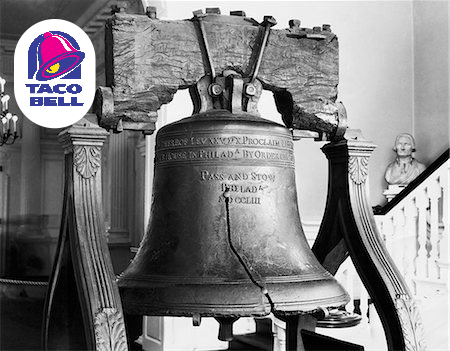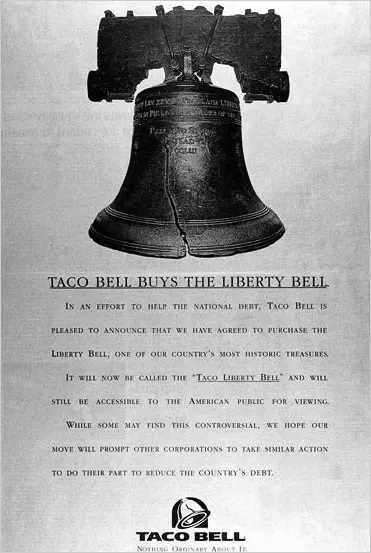
How Taco Liberty Bell hoax got over $25M in free publicity – Witty marketing (7 min read)
Taco Bell – an American-based chain of popular fast-food restaurants which generates about $2 billion in annual revenue.
On April Fools’ Day in 1996, the company announced that it had taken over the Liberty Bell. They also said they would change its name to “Taco Liberty Bell,” and that it would remain available for public viewing. Rapid media coverage gave the whole campaign an extreme reach, with 70M viewers and $25M in free publicity.

Highlights
- March 1996 — Paine & Associates (a PR agency hired by Taco Bell) made plans for the incoming April Fools’ Day campaign for Taco Bell.
- April 1, 1996, before lunchtime — Taco Bell announced “Taco Bell buys the Liberty Bell” in a few major newspapers, including the New York Times and The Philadelphia Inquirer. They claimed that they wanted to pay the national debt with that purchase.
- April 1, 1996, during lunchtime — Taco Bell issued another statement, admitting that the Taco Liberty Bell hoax was just a joke. They called it “The Best Joke of the Day,” and claimed that they would pay $50,000 for the upkeep of the Liberty Bell.
- April 1-5, 1996 — Taco Bell’s sales skyrocketed by over $500,000 which was around 85 times the cost of the entire campaign.
Taco Liberty Bell hoax
The thing worked well, but it was all but a hoax. People were shocked that Taco Bell made them believe it was true. April Fools’ Day made for an excellent occasion for such marketing stunts, and Taco Bell used that opportunity.
Press coverage
Taco Liberty Bell ad, or rather an announcement, appeared in a bunch of the biggest US newspapers. The text sounded serious and official. Except for how strange it was, there was no actual reason not to believe it. It was very professional.

For a cause
The entire Taco Liberty Bell hoax was said to be prepared for the noble goal. Taco Bell said that they wanted to pay the national debt of the Americans by purchasing the Liberty Bell. Taco Liberty Bell hoax went viral because it showed the company in a good position.
Taco Liberty Bell joke on TV
There were no social media back in the 1990s. Giants like Facebook and Instagram launched only after 2000. When Taco Bell prank went viral, there was only a press, a TV, and a radio. It was enough to generate a large reach. Taco Liberty Bell hoax impacted around 70 million people, and it was mainly because of TV shows and radio programs.
Hiring professionals
The idea for the Taco Liberty Bell hoax on April Fools’ Day in 1996 was the invention of the Paine & Associates PR agency. Taco Bell hired David Paine and his team sometime before that day. Paine’s goal was to plan a successful marketing campaign for Taco Bell that would go viral.
The agency has had a few years of experience in PR, since it was founded by Craig Paine in 1990.
The controversies
The Taco Liberty Bell hoax has also risen some controversies. The Liberty Bell is an important national symbol for a lot of Americans. Making jokes about it was seen as something inappropriate by some viewers.
The reaction to the Taco Bell prank was so intense that the National Park Service had to call the press to make an official statement that the bell was never to be sold.
Worth it
The struggle around the campaign turned out to be pretty worth it. Taco Bell spent about $300,000 (about $200,000 went to Paine & Associates). But, the return was larger than that. Paine estimated that Taco Bell has earned about $25M in free publicity.
Good timing
The Taco Bell newspaper ad would never be issued if it hadn’t been for the timing. The ads arrived on March 30 in the newspapers' ad departments. There was no time to analyze them, and the issues for April were already full. They were just pushed through to printing.
The finisher
The cherry on the cake was paying $50,000 by Taco Bell for the upkeep of the Liberty Bell. It wasn't much, but it helped the company to save face.
Good timing

Noble Edge Effect
Taco Bell said that they wanted to pay the national debt by purchasing the Liberty Bell. Marketing campaigns with such noble goals are usually highly successful.
People like it when somebody promises to do something they find important. Paying the national debt would be with the benefit for all Americans.
Von Restorff Effect
We remember strange things better. The weirder is a marketing campaign, the higher the chance that many of its viewers would remember the brand.
Not many things are as strange as buying the Liberty Bell by a chain of fast-food restaurants. Taco Bell shocked people even more also because they said that they planned to change the name of the Liberty Bell.
Internal Trigger
The Liberty Bell is an important national symbol for a lot of Americans. People felt bad about such a symbol being purchased by some fast-food restaurants brand. The controversies around the hoax came from people’s negative reactions to the idea. Some thought that it was somehow immoral.
Even after it was all explained by Taco Bell and the National Park Service, people were still saying that it was wrong to make pranks with the important national symbol of freedom.
Peak-End Rule
The entire viral marketing campaign might have not been so viral at all. People remembered the Taco Bell prank because it started with a stomp (a number of newspaper ads), and finished with a neat accent (Taco Bell’s promise to pay $50,000 for the Liberty Bell’s upkeep).

Taco Bell has simply made use of the April Fools’ Day. They mixed some sense of humor with an effective press advertisement. Good timing played an important role there.
Making good use of holidays and special occasions can bring large returns pretty fast. Also, Paine & Associates were very effective. The campaign was neatly planned before day zero. They knew that newspapers won’t bother checking all the advertisements. There was no time for that, a day before the release of the issue. That was a clever move.
Get your
"oh sh*t, this might work for us!"
moment in the next 5 minutes
Viral marketing case studies and marketing psychology principles that made hundreds of millions in months or weeks
In the first email:
- a step-by-step strategy that made $0-$30M within 9 weeks with $0 marketing budget (case study)
- cheatsheet (PDF) of 10 biases in marketing used by top 2% companies
Other than that:
- weekly original content that helps you STAND OUT by providing more perceived value with less work
(You won't find it anywhere else)

Explore Cognitive Biases in Marketing